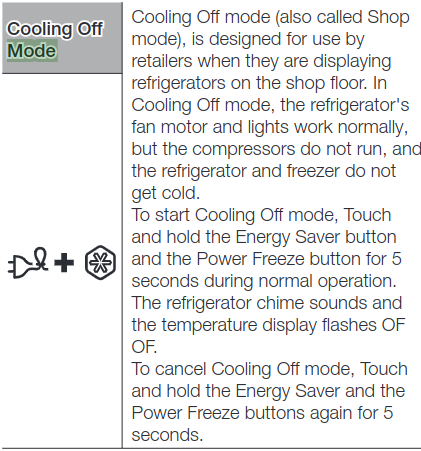How
- Unload the refrigerator and the freezer. There are coolers in the garage that will hold the vast majority of the items that require actual cooling.
-
Disable the cooling mechanism using these instructions from the manual

- Remove the shelving
- Needed to have maximum air movement
- Needed to be able to clean sufficiently
- Clean the bottom of the refrigerator.
- This is important because we are going to accelerate this with a fan and you don't want to blow detritus into the coils or this will happen more often
- Turn on the high volume fan pointed at the refrigerator side
- Fan is in the garage on the shelf closest to the living room to the side of the camping cabinet
- I elevate the fan slightly with a ice pack to it covers more of the inside of the refrigerator
- It is not necessary to worry about the freezer side because it has never completely frozen up yet
- Reverse this order
- Turn off the fan
- Remove the water left from the ice melting
- Clean the shelves as you put them back
- Put the food back
- Yes, I just went out of order, but if you turn on the cooling feature before putting the food back it has to work even harder which could lead to ice buildup again
- Turn on the cooling mode
Why
The primary way ice buildup happens in this refrigerator has been blocking the air vents. To limit this don't push food all the way to the back. There are vents on 4 levels, one by the crisper, so that means none of the shelves are safe to push food against the back wall.
The other way is to put warm food next to the temperature sensors.The sensor are on the top shelf and the self that the meet drawer is mounted under. We typically put our leftovers on the top shelf, so being extra careful about where the sensor is is a good idea.
Leaving the door open so the cooling unit continues to work to keep the items cool, but that cool air is escaping is also an issue. This is compounded by the fact that this unit turns off the internal fans therefore causing the air around the coils to become stagnant.
We didn't have an icing problem for many years after purchasing this refrigerator, but for each of these events it becomes more likely to happen again. The natural accumulation of detritus on the coils (which are not serviceable by the customer on this unit also increases these odds.